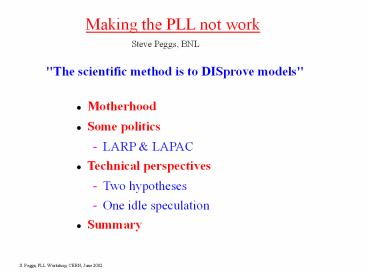Making the PLL not work PowerPoint PPT Presentation
1 / 11
Title: Making the PLL not work
1
Making the PLL not work
Steve Peggs, BNL
"The scientific method is to DISprove models"
- Motherhood
- Some politics
- LARP LAPAC
- Technical perspectives
- Two hypotheses
- One idle speculation
- Summary
2
MOTHERHOOD
- The size of the LHC stresses the early
establishment of feed forward and feed back on
tunes and chromaticities up the energy
acceleration ramp. - This requires Phase Lock Loop (PLL)
instrumentation, similar to the system now
functioning in RHIC. - Full confidence in PLL based operation is also of
vital interest to a future US hadron machine - reduce tight tolerances on magnet performance
- reduce magnet costs.
- (reproducibility?)
3
- Many accelerators have experimented with PLLs,
finding it difficult to achieve robust and
reliable performance - It is necessary to develop more confidence with
the mathematical underpinnings, including
filters, DSP code, and beam dynamics modeling, et
cetera. - Need to develop confidence is through a joint
Instrumentation and Accelerator Physics effort.
4
DRAFT US-LHC (LARP) budget profile
5
(No Transcript)
6
(No Transcript)
7
1.2.2 Phase locked loops (BNL) (from LAPAC
draft, written by Bill Turner) A. Definition of
goals and deliverables RHIC is the first
two-ring collider built since the ISR. The LHC
will be the second. There are many similarities
between these RHIC and LHC machines, similarities
that make RHIC a good test bed for LHC beam
control. Luminosity lifetime in both machines
will be limited by beam-beam tune shift/spread,
and perhaps by electron cloud effects. Overall
luminosity will then be optimized by fast and
efficient machine cycles. Machine cycle time is
governed by fill time, ramp rate of the
superconducting magnets, and the need to include
a hysteresis loop in the cycle. In RHIC the
practical minimum cycle time is around 30
minutes. This long cycle time increases the
pressure for efficient ramps. At maximum
intensities instabilities will play a role,
particularly during acceleration. This also
increases the pressure for good control of tune
and chromaticity on the ramp. Commissioning
experience during the RHIC 2000 and RHIC 2001
beam runs has clearly driven home the importance
of fast, accurate, and reliable measurement and
control of tune, chromaticity, and coupling. To
meet this obvious need a variety of measurement
systems have been developed. Early in the course
of this development the desirability of tune
feedback during acceleration became clear. To
this end a prototype phase locked loop (PLL) tune
measurement system was commissioned .....
(plus several pages more, including budget,
schedule ...)
8
Hypothesis 1 joint modeling required
- Observation robust and reliable PLL operation
both - appears to be achievable
- is clearly non-trivial
- Conjecture an accurate simulation model needs
both - Q loop / PLL loop / DSP modeling intimate with
- beam dynamics / beam distribution / ramping
- An accurate simulation will predict how to lose
the lock, enabling controlled experiments
9
Hypothesis 2 beam dynamics is simple
- Element-by-element tracking unecessary
- Plausibly, only need to know
- Qx, Qy, Qs tunes
- ?x, ?y chromaticities
- q2 2-D global coupling vector
- dq2/d? skew coupling (perhaps?)
- TKQ quad PS matrix - or is it part of other
block? - ???? at pick-up and kickers local coupling
matrix - ?, ?p/p, .. initial beam distribution
- Plus also? octupolar tune spread, beam-beam,
- reactive/resistive damping, space charge,
- Sample-by-sample interface, PS ripple
- What static or ramped values lose the lock?
10
Remote operations
- Generic question what gives the remote crew the
"authority" (sociologically speaking) to run a
shift on the local accelerator? - One answer send the local "crew chief" to the
remote Virtual Control Room. - Does this extrapolate to sending Dave McGinnis to
the HERA CR when Steve Herb et al want to
participate in Fermilab PLL studies???
11
SUMMARY
- RHIC/LHC have an MoU, but it is wise to also
consider the interests and resources of other
labs DESY, GSI, FNAL, TRIUMF, .. - Only careful and deliberate joint modeling
(Instrumentation and Acc Phys) will be
successful.. - .. in predicting the experimental stability
limits -- how ill-conditioned can a beam be? - What does the model need? Who (plural
individuals) will develop it? - The timescale is NOT short
- What is the post-workshop work plan?

